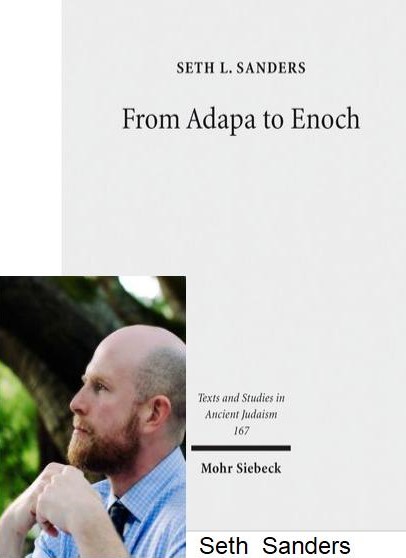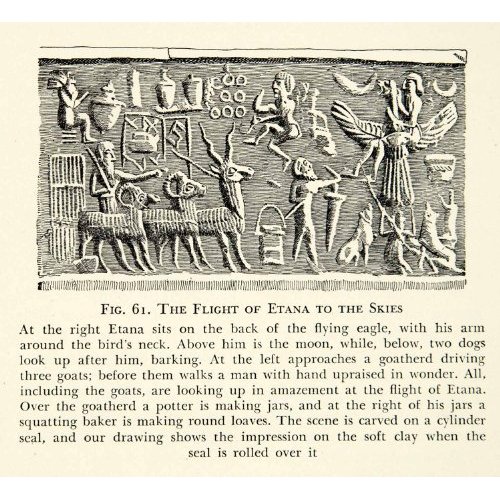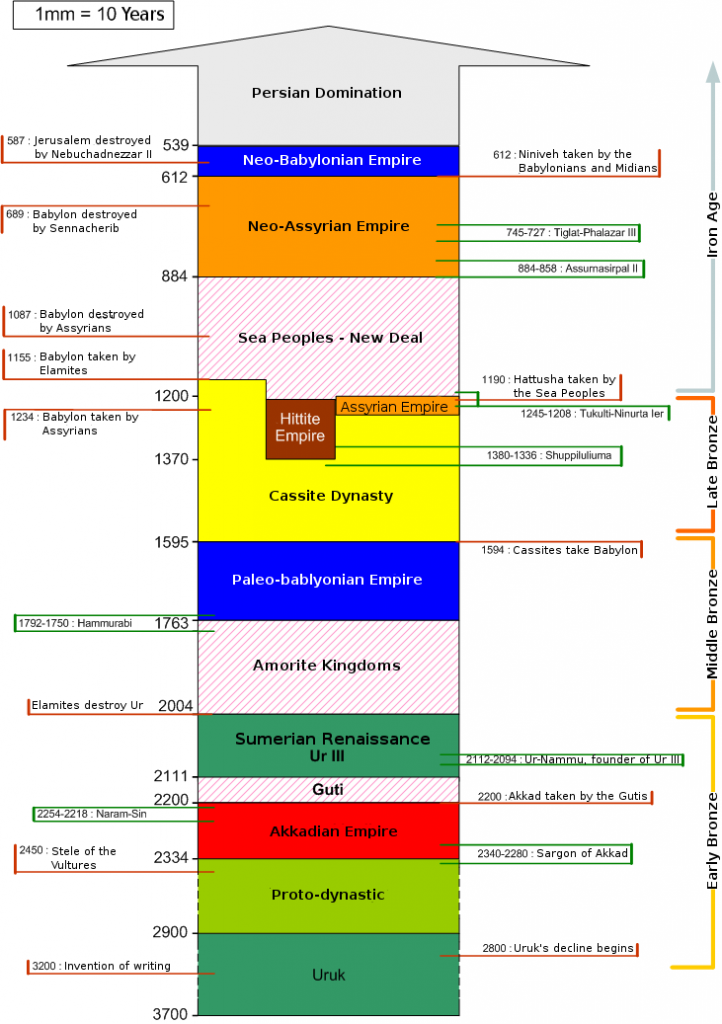 I am looking forward to sharing some of the research of Seth L. Sanders published in From Adapa to Enoch: Scribal Culture and Religious Vision in Judea and Babylon (2017). I sought out the book in expectations that it would open to my understanding the ancient thought-world that lies behind our own religious heritage. Sometimes we will hear that a biblical person or trope has a parallel of sorts in ancient Mesopotamia yet give little thought to the fact that the time gap between the two can be half a millennium or more. How can we meaningfully speak of an influence between A1 and A2 if they are separated by such a span? Besides, how credible is it to imagine different cultures, languages, races, being so frozen within a common umbrella culture that never changes so that a story of a hero’s heavenly journey in Babylonia can have the same meaning and function as another hero’s heavenly journey many centuries later and hundreds of miles distant?
I am looking forward to sharing some of the research of Seth L. Sanders published in From Adapa to Enoch: Scribal Culture and Religious Vision in Judea and Babylon (2017). I sought out the book in expectations that it would open to my understanding the ancient thought-world that lies behind our own religious heritage. Sometimes we will hear that a biblical person or trope has a parallel of sorts in ancient Mesopotamia yet give little thought to the fact that the time gap between the two can be half a millennium or more. How can we meaningfully speak of an influence between A1 and A2 if they are separated by such a span? Besides, how credible is it to imagine different cultures, languages, races, being so frozen within a common umbrella culture that never changes so that a story of a hero’s heavenly journey in Babylonia can have the same meaning and function as another hero’s heavenly journey many centuries later and hundreds of miles distant?
Sanders hopes to find answers to those sorts of questions. How was it that a story of a heavenly journey by Enoch in Hellenistic era texts echoed similar stories in Mesopotamia 500 or even 1000 years earlier? And it didn’t just end with Enoch. Paul, we know, also spoke of experiencing a heavenly journey, and we will see in these posts that his letters spoke of other experiences for all those “in Christ” that have remarkable correspondences with the experiences of Enoch and his predecessors and with the scribal elites who read and used these texts.
I said I sought out the book. The book appeared in my mail box a few weeks after I had requested a review copy from Mohr Siebeck. I heard nothing back from them but I presume it was them who forwarded the book to me. So for that I’m thankful.
I have mentioned the literature of the heavenly journeys of sages. Hellenistic era Judea and Babylonian-Assyrian era Mesopotamia also shared literature of exegetical commentaries and astronomical science.
If these changes are part of a shared development in the intellectual life of the region, shifts in a common ancient Near Eastern scribal culture, why do they only appear in Judea so much later, under the new conditions of Hellenism? Ancient Near Eastern scribal culture spans more than 3,000 years, far-flung cities and empires, and many languages and writing systems. The risk of examining it as a whole is there may not be a whole – at least, we will be better able to tell once we have seen it intimately, at specific moments, in particular forms. (p. 1)
Before addressing some of Sanders’ criticisms of past approaches to similarities between Iron Age Mesopotamian and Hellenistic Judean literary cultures I choose to start with the earliest known story of a heavenly journey from Mesopotamia.

The Ascent of Kings: Etana
We have seal impressions of the story of Etana riding to heaven on the back of an eagle predating our first written reference to Etana. The seals date from the Akkadian period (prior to 2000 BCE) and the name Etana appears in the Sumerian King List from the Third Dynasty of Ur (ca 2000 BCE). The narrative of the myth is found in the ensuing Old Babylonian period.
The Sumerian King List states:
Etana, a shepherd, the one who to heaven ascended,
the one who consolidated all land,
became king and reigned 1,560 years;
Balih, son of Etana,
reigned 400 years.(Translation from Jacobsen)
Apparently following the argument of Glassner Sanders’ writes
Thus Etana, the seventh named king of the second series, is in a way the first “real” ruler, as suggested by his pastoral origins as a “shepherd,” the founding act – he “unified all the lands” – and his special status as one who “ascended to heaven”.
This Etana is the first record of what will become a series of wise revealers of heavenly mysteries. This original heavenly visitor, however, is not a scribe like later visionaries and revealers, but a king. We will see the significance of the change from king to scribe in this role in future posts.

Here is the earliest known myth from the Old Babylonian period. It informs us of the origin of kingship.
The great gods, the Anunna, who decree fate sat to deliberate about the land.
The creators of the world, the establishers of creation
………. the divine Igigi
decreed the Festival (of kingship) for the people,
(but) a king they had not (yet) established among the many peoples.
At that time headcloth and crown were unworn,
nor was scepter inlaid with lapis,
not a single throne-dias was built –
sevenfold were the gates bolted against the valiant,
scepter and crown, headcloth and staff
lay before Anum in heaven –
there was no ruler for the people.
Kingship came down from heaven;
[ … IJshtar looked for a k[in]g.(Sanders, p. 31)
The ritual paraphernalia that made the king were kept guarded in heaven until the gods found a suitable earthly candidate.
Next, we find a Neo-Assyrian text in which Etana’s status as a shepherd is no longer meant only literally, but also metaphorically: he becomes the shepherd of the people.
Etana is appointed king but his wife, through disease, is childless. His wife is shown the solution to the lack of an heir in a dream — “a plant of birth”. She tells Etana who in turn prays to Shamash that he also be shown the same plant and where to find it.
The scene switches to an eagle and a snake sharing a tree and entering into a pact to look out for and assist one another in hunting for food. But the eagle breaks his word and eats the young of the snake. Knowing its guilt the eagle imagines it will fly to heaven to escape the wrath of the snake it knows will come, but before it does so the snake appeals to the same god, Shamash, for justice.
Keep that little datum in mind: the eagle resolves to fly to the heights of heaven but is instead cast down to . . .
Shamash responds by instructing the snake how to trap and disable the eagle in a mountain. This results in the snake seizing the heel of the eagle and disabling its wings so it can no longer fly and casting it into a pit.
At this point Etana prays to Shamash for the plant that will enable him to have an heir. Etana really lets Shamash know how unfair he has been to him: Etana has sacrificed sheep and incense in abundance but got nothing in return. The divinely wise Shamash decides to “kill two birds” with one gesture. He instructs Etana to find the eagle in that pit in the mountain, rescue it, repair its wings, and ask it to fly him to find the “plant of birth”.
The eagle needs to be shown the location of the plant in a dream, too, and it sees a wonderful vision of passing through seven gates of heaven to reach Ishtar:
We passed through the entrance of the gates of Sin, Shamash, Adad and Ishtar,
[We bowed down together,] you and I.
I saw a house with windows [..] a seal […]
I pushed aside [ X ] and entered
Seated inside was a [young woman,]
Awesomely crowned, her features beautiful.
A throne was set up and the ground was trodden down.
At the base of the throne [fierce] lions lay . . .
Sanders notes that this heavenly structure is mirrored by the way to the underworld of death, ruled by Nergal. Both have seven gates through which one must pass. (The ghost unable to enter will be tormented as it wanders restlessly throughout the earth.) Of significance here is that the word for “mountain” (see above) is the same as for “netherworld”. We will later find that Etana continues to exude power for earthly kings from his own eventual place in that netherworld. Outside this particular myth Etana is a netherworld hero and ruler.
The dream, furthermore, has a terrifying conclusion. We lack all the text but fragments inform us that Etana dies — though presumably after acquiring the “plant of birth” because he is said to have an heir.
What is this myth about? The introductions to the myth make its meaning clear: they inform readers that it is about
the first king, the founding of kingship, and kingship’s heavenly origin.
Different versions of the myth further indicate that the story was not simply repeated by rote but that it was subject to contemplation and variations in the significance or meaning of particular details. That point alone presents many of us with a view of Mesopotamian culture as being more dynamic and fluid than I suspect many of us have assumed.
Funerary texts call on Etana as ruler of the underworld. Some texts even designate him as a god. Etana becomes a figure who experiences both the world above and that below. (He is not the only one so privileged in Mesopotamian myth.) Etana is the first king, the one to whom were revealed the secrets of kingship from heaven, the one who became ruler in the world below and to whom the living appeal in incantations and rituals of various kinds in order that he can wield his power to assist them.
The narrative of Etana is a royal myth in which the secret brought down from heaven is that of sovereignty.
If the first myth of a heavenly ascent to acquire divinely guarded secrets, and whose hero was thereafter called upon from beyond this side of grave for help and guidance, belonged to a king, how and why do we not too long afterwards find a new versions of the myth in which the king no longer has that central role. The king will be replaced by a scribe and the secrets will be of a wisdom that is not directly related to the rituals of sovereignty.
. . . Continuing . . .
Sanders, Seth L. 2017. From Adapa to Enoch: Scribal Culture and Religious Vision in Judea and Babylon. Tübingen, Germany: Mohr Siebeck.
If you enjoyed this post, please consider donating to Vridar. Thanks!

Try this – people sleep, people dream while sleeping, in dreams people “see” dead relatives (ghosts), ” travel” magically to places that aren’t real and “talk” with brings that don’t exist. Now add that throughout humanity’s existence drama were(& to many today still are) “real”.
It’s not a meme, it’s not oral tradition, it’s not legend – it’s ignorance of biological processes. And it takes zero effort to pass along. Let me tell you about I made a great friend through a horrifying sleep paralysis incedent…
Gosh, a king has a vision involving a trip to heaven from which he acquires the divine approval of his kingship. This story gets passed around as being true. I’m shocked, shocked I tell you!
May I recommend Andrei Orlov’s recent study “The Greatest Mirror: Heavenly Counterparts in the Jewish Pseudepigrapha (NY: SUNY Press, 2017). He describes how the individual/character assumes a sort of double identity of sleeping on earth and being installed in heaven at the same time! A celestial alter-ego if you will. Ascent and seeing your double are one in the same experience.
Yes, Timothy
thank you for the entry
“May I recommend Andrei Orlov’s recent study “The Greatest Mirror: Heavenly Counterparts in the Jewish Pseudepigrapha (NY: SUNY Press, 2017). He describes how the individual/character assumes a sort of double identity of sleeping on earth and being installed in heaven at the same time! A celestial alter-ego if you will. Ascent and seeing your double are one in the same experience.”
Yes Andrei Orlov not sure if he is still at Marquette Univ where I was enrolled as a Ph.D student in 89-91) ..he came shortly after I think). His works are quite interesting and I have learned much from them…Haven’t read this most recent one but others of his..I recall Dark Mirrors… dealing with the satan and demons , etc.
I am presently working on a major book on the satan….not so much demons…and I don’t think “demons” should be directly connected to the satan figure…
I have a chapter dealing with this issue in the light of some very interesting texts…
eg. Zech. 3:1ff a fascinating text where “Joshua” the high priest ( Jesus language!!) is present during the Council has arrived to judge his fittedness to be the high priest of the new Temple to be built..on earth…. I am working extensively on the relation of Zech. 3 etc and its connection to the “high-priest” Joshua or Jesus of the new temple he has built in the Gospel of Mark (chapter 2)… there is opposition to Jesus acting as a priest….. this opposition is identified by the collective satan on earth while the satan (singular or plural… depending on various contexts regarding the appearance of the satan….
lots more can be said…
but thank you for making me aware of this new book…..I can hardly wait to get into it…
Cheers….
Yes, he is still at Marquette and still working on the literature of the Pseudepigrapha. A body of literature that can still be tapped for conceptual clues to the interpretation of early Christian literature and the trajectories of ideology and practice in early Judaism and early Christianity.
The book I’m discussing now (Sanders’ From Adapa to Enoch traces the historical evidence for the evolution of the Enochs and Pauls becoming identified with the divinity. Sanders works with the limitation that we have evidence for the subjective experiences of those who did become identified with a divinity so relies entirely upon what the texts themselves tell us, and it’s quite a lot.
Neil, I am looking forward to your review/analysis of Sanders’ important new book. He carefully details the transmission of cultural aspects of the intellectual world of ANE into the highly nuanced culture of early Judaism via the re-framing of cultural patterns and genres (I am reading his book as well). I am interested also in how he details the Aramaic scribal work of taking early Akkadian legal texts from the public and political arena and assimilating it (for lack of a better word) into 2nd Temple literature that becomes more esoteric, scholarly, etc. How does a legal text become, through commentary and interpretation, a kabbalah (if you will)? He has written a major contribution to literary history and thought between ANE and 2nd Temple literature.
Keep up the good work Neil!